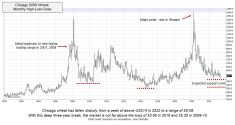World corn and soybean markets are under pressure due to favourable spring weather in the United States and strong competition from South America for export business. Weaker energy prices are also weighing on row crops.
Quick look
Soybeans: Ontario soybean crop is expected to drop by 100,000 acres.
Corn: U.S. corn carryout is expected to be large due to declining demand.
Wheat: Risk premium will continue for wheat in the short term.
Ethanol processors have reduced their daily grind or shut down for the time being.
Read Also

Scouting advised for soybean aphids
Soybean aphids have been spotted in a few fields in southern Ontario that haven’t seen soybean aphids in quite a…
Wheat prices have held value due to drier concerns in the Black Sea region and the announcement that Russia would halt exports after mid-May. Ideas are that the Ukraine will also follow suit.
In Europe, logistical constraints due to COVID-19 continue to limit export potential. On the flip side, optimal conditions have enhanced crop development for U.S. winter wheat crops. Seeding is slightly delayed for spring wheat in the U.S. Northern Plains and Canadian Prairies.
Ontario farmers have started spring field work and there are reports of corn planting in the southern regions. Compared to early April, Ontario corn bids are down about 20 cents per bushel, while nearby soybean bids are off about 30 cents a bushel. Ontario wheat prices remain elevated relative to world values due to the tight fundamental situation. We’ve fine-tuned our 2020 Ontario crop projections.
Soybeans
We’re projecting Ontario farmers to plant three million acres of soybeans this spring, down four per cent from 3.1 million tonnes last year. Using a five-year average yield of 46.7 bushels per acre, production has potential to finish at 3.9 million tonnes, up from the 2019 output of 3.7 million tonnes.
Farmers have been discouraged with the price outlook due to the lack of Chinese buying interest. Canadian crop year-to-date exports to the end of February 2020 were 2.4 million tonnes, down from 3.3 million tonnes last year. The weaker Canadian dollar has been supportive by enhancing export offers and making imports less attractive; however, the currency can only do so much to sustain the current price structure as Brazil and Argentina are also contending with weaker currencies.
Old crop soybean prices are under pressure. The Argentine soybean harvest is nearing 40 per cent complete while the Brazilian harvest is basically wrapped up. Despite loading delays due to COVID-19 at some ports, we continue to see strong South American competition on the world market limiting any upside.
In the April World Agricultural Supply and Demand Estimates report issued by the U.S. Department of Agriculture, Argentine soybean production was estimated at 52 million tonnes, down from March projection of 54 million tonnes and down from the 2019 crop of 55.3 million tonnes. Brazil’s crop was estimated at 124.5 million tonnes, down 1.5 million tonnes from the March number but up 7.5 million tonnes from 2019. We’re looking for the USDA to eventually lower its 2019-20 export projection due to the limited export interest over the past month. We’re looking for U.S. 2020 production to reach up to 112 million tonnes, up from the 2019 crop size of 97 million tonnes. As of April 19, the U.S. soybean crop was two per cent planted, up from the five-year average of just one per cent.
What to do: We have a bearish outlook in the short term. We’ve advised producers to be 80 per cent sold on old crop and 20 per cent sold on new crop. We’re waiting until the upcoming crop is more established before making our final sales recommendation.
Corn
Corn has been the weak link for cereal grains over the past month due to weaker ethanol demand and growing supplies for the 2020-21 crop year. We’ve only begun to see the plight in the ethanol industry and this could continue throughout the next crop year with energy prices at historical lows. Ontario has been an island on the world market with the hangover effects of last year’s harvest delays.
This will change as we approach new crop delivery. The Ontario corn market will function to encourage demand during the 2020-21 crop year. We continue to project a year-over-year acreage increase of five to 10 per cent in Ontario. To reiterate from our last issue, Ontario production is expected to finish near 9.5 million tonnes, up from the 2019 crop of 8.6 million tonnes.
The Argentine corn harvest is about 35 per cent complete while the Brazilian second corn crop is in the vegetative or early reproductive phase. According to the USDA, Argentine farmers are expected to harvest 50 million tonnes this year, down one million tonnes from last year; the Brazilian crop is projected to finish 101 million tonnes.
April’s WASDE report was considered bearish for the corn market. The most significant change was a decrease in ethanol use. Without going into detail, the 2019-20 U.S. corn carryout is now projected to finish at 53.2 million tonnes, up from the earlier projection of 48 million tonnes.
We’re looking for the USDA to decrease its export projection and make further downward revisions to ethanol use on upcoming reports. We continue to project a 2020 crop size of 389 million tonnes, up 41 million tonnes from the 2019 crop, which will cause the 2020-21 U.S. carryout to balloon to 78 million. As of April 19, the U.S. corn crop was seven per cent planted compared to the five-year average progress of nine per cent.
What to do: We advise producers to sell the final 20 per cent increment of their 2019 crop bringing total sales to 100 per cent. We want to remind producers that we’ve been 20 per cent sold on new crop for some time.
Wheat
For old crop positions, the wheat market is contending with export restrictions in Ukraine and Russia along with logistical and supply constraints in Europe. For new crop positions, traders are watching Northern Hemisphere weather as they adjust production estimates from the major exporters.
Ukraine exports reached 18.6 million tonnes for the week ending April 17, up from 12 million tonnes last year for the same period. The Ukraine government had an agreement with traders that the maximum wheat exports would be limited at 20.2 million tonnes. We expect to see more stringent constraints in upcoming weeks as the export volume nears agreed targets.
In Russia, it appears that wheat exports will be suspended in mid-May according to a Dow Jones report. In Europe, companies are struggling to move wheat stocks into export position. There are major delays in rail movement and truck capacity is down about 30 per cent from normal. Lower river levels have also made barge movement difficult and expensive. This environment has put the focus on Canada, Australia and the U.S. to supply world requirements until new crop comes on stream.
For new crop production, traders are now expecting Russian production to finish in the range 72 to 80 million tonnes. This compares to earlier projections near 85 million tonnes and the 2019 output of 73.6 million tonnes. About 50 per cent of the Russian wheat crop is spring wheat and 50 per cent is winter. It’s still early in the season in Russia. The Ukraine crop is expected to finish near 27 million tonnes, down from last year’s crop of 29 million tonnes.
In the U.S., the winter wheat crop was rated 57 per cent good to excellent as of April 19, down from the previous week’s rating of 62 per cent and the five-year average of 62 per cent. The U.S. hard red winter crop is estimated at 21.8 million tonnes, down from the 2019 output of 22.7 million tonnes.
Despite lower acreage, above average yields are anticipated. U.S. soft red winter wheat production is expected to be about 8.1 million tonnes, up from 6.5 million tonnes last year. Seasonal rains are in the forecast for Kansas. Keep in mind that U.S. farmers sell nearly 50 per cent of the winter wheat in the summer months. Spring wheat seeding is slightly delayed in the U.S., but in Western Canada, it’s still early and moisture conditions are excellent for average yields.
We mentioned in the previous issue that Ontario winter wheat production is expected to finish near 2.5 million tonnes, up from the 2019 crop of 1.4 million tonnes. During the 2019-20 crop year, the Ontario wheat market functioned to ration demand by trading at a premium to world values; however, during the 2020-21 crop year, the market will function to encourage demand. Prices will have to adjust to enhance exports to Mexico and the U.S.
What to do: We’ve advised producers to be 80 per cent sold on old crop and 20 per cent sold on new crop. The market is expected to incorporate a risk premium in the short term due to limited exports from the Black Sea region. However, the market has a bearish sentiment for new crop positions.















